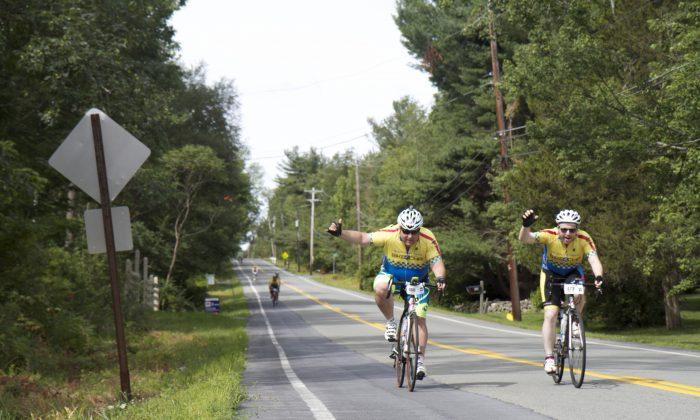At Grand Central Terminal, the heavyweights of NYC transportation and their national partners in the Transportation for America Campaign (T4), released “Build for America: A Five Point Plan to Get Our Economy Moving.” Their plan has the potential to create 100,000 green jobs in New York and millions more nationally. The rebuilding of New York City’s century –old subways, the completion of major projects like the Second Avenue Subway, Access to the Region’s Core (ARC) and East Side Access, along with the development of initiatives like Bus Rapid Transit (BRT) will diversify the commuting choices for hundreds of thousands of New Yorkers, cut congestion, and drastically reduce America’s dependence on oil.
On Wednesday the case for investment in this bold economic agenda was put forward. Regional Plan Association will release a comprehensive transportation investment blueprint for New York City and Northern New Jersey on Thursday. The in-depth report, entitled “Tomorrow’s Transit: New Mobility for the Region’s Urban Core,” announces new and upgraded subway, bus, commuter rail, ferry and light rail projects. The nearly forty recommendations focus on providing service to underserved areas of the city, and work to improve connections in the existing network.
Elliot Sander, Executive Director and CEO of the Metropolitan Transportation Authority (MTA) said it’s impossible for New York to compete with big cities around the world without the support of Congress to maintain and improve the public transit system in New York.
“Our ridership has grown 40% over the past decade, and this year is up another 6%,” said Sander. “The MTA’s robust mass transit network keeps New York economically competitive with the world cities like London and Shanghai that are investing in their transit systems.”
“Nationwide, we have the rare opportunity to simultaneously invest in major projects, to create thousands of new jobs and, crucially, to revive a very shaky economy,” explained Rep. Jerrold Nadler. “If we do not focus our resources on transportation and infrastructure, we will not only suffer the economic consequences but will also suffer the continued deterioration of our aging and unsafe infrastructure, particularly in the northeast.”
The U.S. currently spends $70 billion a year on transportation infrastructure and many believe that Congress should now do what has been done in every recent recession, and invest still more to stimulate economic recovery. However, simply using that money to build highway projects conceived in the last century is unlikely to help, warns the T4 coalition.
“Investing in the infrastructure of the 21st century is one of the most important things the federal government can do right now,” said Janette Sadik-Khan, NYC Transportation Commissioner and President of NACTO, an organization of city transportation officials. “We’re calling on the next president to support the vital transportation networks of our nation’s metropolitan areas, where investment can make a real difference for millions of people.”
T4’s plan ‘Build for America’ calls for investment in public transit, high-speed and intercity rail, neighborhoods that are less car dependent and that are more walkable and more affordable, and restoring the thousands of roads and bridges in failing condition across the United States. Specifically, New York City’s T4 partners are asking the next President and Congress to work together on their plan.
The Five Point Plan
1. BUILD TO COMPETE—with China and Europe, by modernizing and expanding our rail and transit networks to reduce oil dependence and connect the metro regions that are the engines of the modern economy.
2. INVEST FOR A CLEAN, GREEN RECOVERY—through cleaner vehicles and new fuels as well as the cleanest forms of transportation – modern public transit, walking and biking ; and for energy-efficient, sustainable development.
3. FIX WHAT’S BROKEN—before building new roads, restore our crumbling highways, bridges and transit systems.
4. STOP WASTEFUL SPENDING—and re-evaluate projects currently in the pipeline to eliminate those with little economic return that could deepen our oil dependence.
5. SAVE AMERICAN MONEY—Provide more travel and housing options that are affordable and efficient, while helping people avoid high gas costs and traffic congestion. Save taxpayer dollars by asking private developers who reap real estate rewards from new rail stations and transit lines to contribute toward that service.
“There has never been a more important time to invest in our infrastructure. In the aftermath of the economic crisis, sustaining and maintaining New York’s vast transit system will provide a foundation for the economic transformation that lies ahead,” said Robert Yaro, President, regional Plan Association and co-chair, Empire State Transportation Alliance.
Events similar to this one are being held across the country, including Atlanta GA, Columbus, OH, Chicago, Milwaukee, Phoenix, Seattle, and San Francisco.
A Win-Win Plan
As well as the economic benefits of this infrastructure revitalization to Americans, the environment will receive vital stress relief, and by reducing carbon emissions many scientists believe will have the direct effect or reversing of global warming.
“New Yorkers have one third the impact on the environment than your average American. The smartest thing to do if you want to save the planet is move to New York,” said Sadik-Khan.
T4 states that transportation makes up a third of greenhouse gas emissions nationally and an even higher percentage in many states. Giving Americans more option apart from driving is critical to a climate crisis solution.
In T4’s analysis on the national transport situation, they see many Americans are stranded without transportation choices that are affordable, efficient, and convenient. Americans are looking to cut back on driving, but that proves difficult when only half have access to public transportation and most live in places built for car dependence. Meanwhile, metro areas are absorbing millions of new residents as the population grows toward 400 million, and struggle to accommodate them while remaining livable.
Giving people options other than driving also helps reduce spending at the gas pump. According to T4, families living in neighborhoods adjacent to rail transit spend an average of 9 percent of their household budget on transport as opposed to 25 percent for those in automobile dependent areas.
Public transportation already saves the U.S. as much as 4.2 billion gallons of gasoline each year. By building a transit, walking, and biking infrastructure that helps more people live in closer proximity to their daily needs, T4 foresees saving America billions more gallons.
In 2005 alone, public transportation saved Americans 340 million gallons of gas—resulting in a total savings of $10.2 billion.
The Cost
Today, 78 metro areas around the country are working to raise funds for much needed rail and rapid bus lines. A total of $240 billion in transit investments to expand or create service is needed. Meanwhile, the Federal Highway Administration has identified the need for $512 billion in investments over the next several years to restore our existing roads, bridges, and transit systems.




